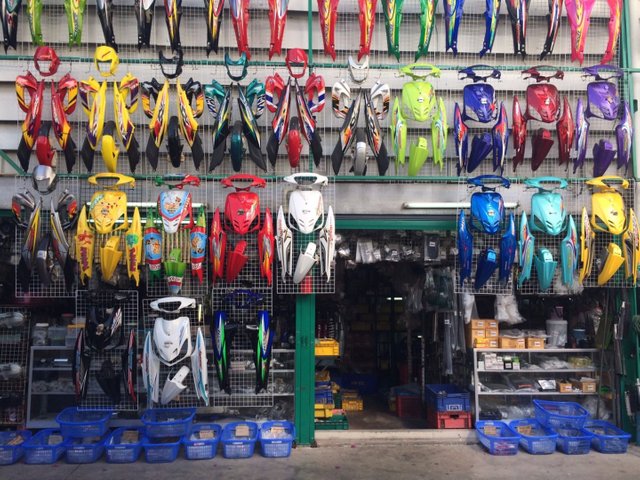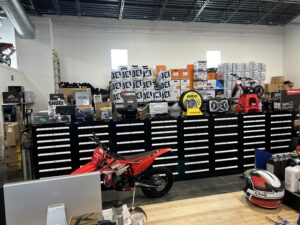Top MX Gear NZ: Prepare for Your Next Off-Road Journey
Top MX Gear NZ: Prepare for Your Next Off-Road Journey
Blog Article
Recognizing the Vital Parts of a Motorbike: A Comprehensive Guide for Enthusiasts
For bike lovers aiming to raise their riding experience and ensure their bikes run smoothly, recognizing the necessary components of a bike is vital. Each component, from the engine's elaborate operations to the vital role of the braking systems, not just influences performance but likewise safety and security and comfort. This guide will stroll via the basic parts that every biker need to recognize with, enabling notified options in both maintenance and potential upgrades. As we start this exploration, one must ask: just how does each part interact to create the smooth adventure every enthusiast seeks?
Engine Elements

The camshaft plays an essential duty in controlling the timing of the engine's valves, ensuring the exact opening and closing necessary for efficient fuel and air consumption, as well as exhaust expulsion. This timing is essential to preserving optimal engine performance and performance. Furthermore, the carburetor or gas injection system, depending on the motorbike model, is accountable for mixing air with fuel in the appropriate ratio for burning.
The cooling system, either air or liquid-based, functions to keep the engine's temperature level within operational limitations, protecting against getting too hot and guaranteeing longevity - moto parts nz. Each element, diligently developed and integrated, adds to the smooth procedure of the engine, specifying the motorcycle's power outcome and general efficiency
Transmission System
Integral to the motorcycle's functionality, the transmission system makes sure reliable power transfer from the engine to the wheels. This system makes up several essential components, including the clutch, gearbox, and final drive, each playing a crucial role in converting the engine's power into movement. The clutch, generally operated by a hand lever, serves to engage and disengage the engine from the transmission, enabling smooth equipment adjustments and controlled velocity.
The transmission, often referred to as the transmission proper, contains a set of gears that motorcyclists can by hand shift with to adjust the bike's rate and torque output. These gears are set up in a series that allows the motorcycle to accelerate smoothly and keep optimal engine efficiency across numerous speeds. A lot of motorcycles use a sequential transmission, needing the motorcyclist to move gears in a predetermined order.
Braking Mechanisms
While recognizing the transmission system is crucial to taking advantage of a motorbike's power, similarly essential is the ability to regulate and quit that power effectively, which is where braking mechanisms enter into play. Brakes are important for safety and security and performance, supplying the cyclist with the essential control to browse numerous surfaces and conditions. Commonly, motorcycles feature two kinds of braking systems: disc brakes and drum brakes.
Disc brakes are extra prevalent in modern-day motorcycles due to their superior efficiency. This system provides far better heat dissipation, regular efficiency, and enhanced quiting power, specifically in wet problems.
On the other hand, drum brakes, though much less common, are still discovered in some bikes. They work by pressing brake shoes versus the internal surface area of a drum affixed to the wheel. While typically much less reliable in warmth dissipation and stopping power, drum brakes are easier and extra economical.
Understanding these braking systems' nuances enables motorcyclists to keep their bikes effectively and appreciate the engineering that guarantees effective and risk-free stopping.
Suspension and Steering
Suspension and steering systems are important elements that substantially affect a bike's handling and adventure convenience. The shock absorber, including forks at the front and shock absorbers at the back, soaks up roadway abnormalities, boosting security and control. Front forks, typically telescopic or inverted, compress and rebound to mitigate effects, while back shock absorbers maintain tire call with the roadway, crucial for traction link and safety.
Guiding, focused around the handlebars, links the biker to the bike's directional control. The guiding head bearings make certain smooth procedure, allowing specific ability to move. Proper positioning and upkeep of these bearings are essential for foreseeable guiding reaction and lowering cyclist exhaustion.
The suspension's adjustability is one more crucial aspect; preload, damping, and rebound setups enable personalization to suit numerous riding problems and designs. This versatility is vital for optimizing efficiency, whether navigating metropolitan streets or taking on sturdy routes. Advancements like digital suspension systems use real-time modifications, enhancing adventure high quality across diverse terrains.

Electrical Equipments
After guaranteeing a controlled and smooth ride with efficient suspension and guiding systems, interest transforms to the electrical systems, a pivotal facet of contemporary bikes. These systems play a critical duty not just in beginning the engine however likewise in powering numerous components that enhance the performance and security of the motorcycle.
At the heart of a bike's electrical system is the battery, which shops electric energy required for beginning the engine and powering our website auxiliary systems - motorcycle parts nz. The alternator or generator, paired with the rectifier-regulator, ensures the battery continues to be billed while the motorcycle functions, converting mechanical power right into electrical energy and preserving voltage levels
The ignition system, one more essential component, is accountable for stiring up the air-fuel mix in the engine's cylinders. Modern motorbikes commonly make use of an electronic ignition system, providing higher efficiency and dependability contrasted to typical systems.
Illumination systems, consisting of headlights, tail lights, and indicators, are additionally vital, making certain presence and safety and security for the cyclist. Additional digital parts such as sensing units, control devices, and presents add to sophisticated functions like fuel injection monitoring, anti-lock stopping systems (ABDOMINAL MUSCLE), and digital dashboards, further boosting the riding experience.
Conclusion
A detailed comprehension of a bike's important parts, consisting of the engine, transmission system, braking devices, suspension, guiding, and electrical systems, is indispensable for fanatics aiming to optimize security, convenience, and performance. Mastery of these components permits informed choices relating to maintenance and upgrades, inevitably improving the riding experience. By integrating this expertise, motorcyclists can ensure their bikes run at peak effectiveness and integrity, consequently making best use of both satisfaction and longevity of their automobiles.
For motorcycle fanatics looking to boost their riding experience and ensure their bikes run smoothly, recognizing the vital parts of a motorcycle is critical.Important to the bike's motocross knee guards functionality, the transmission system guarantees effective power transfer from the engine to the wheels.While recognizing the transmission system is vital to harnessing a motorcycle's power, similarly crucial is the capacity to regulate and quit that power effectively, which is where braking mechanisms come into play. Normally, bikes include 2 kinds of braking systems: disc brakes and drum brakes.
An extensive understanding of a bike's necessary elements, including the engine, transmission system, stopping devices, suspension, guiding, and electric systems, is important for enthusiasts intending to optimize safety, efficiency, and convenience.
Report this page